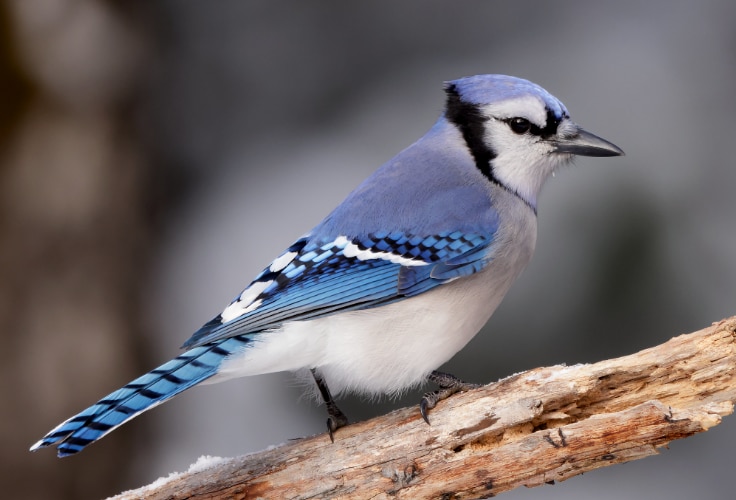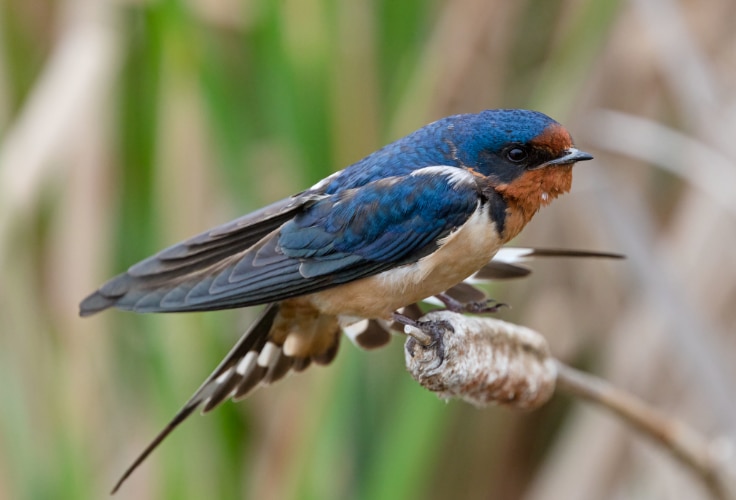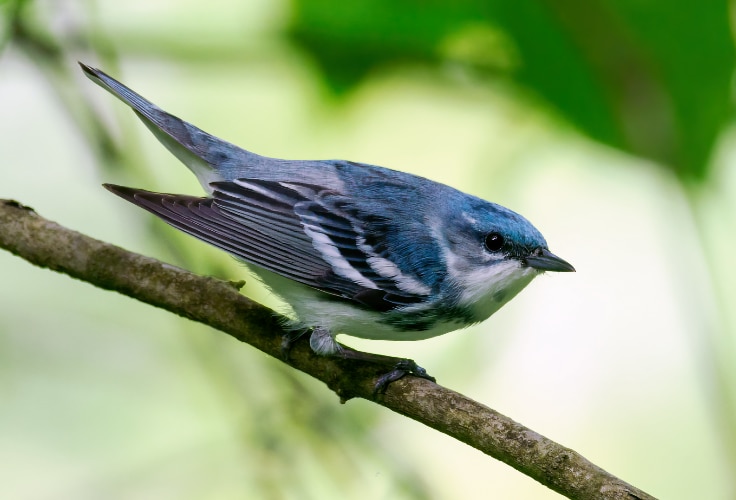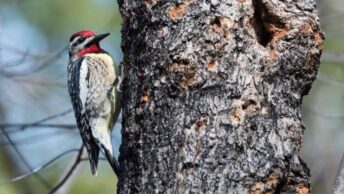Pennsylvania is home to a striking mix of blue birds, from the familiar eastern bluebird perched on fence posts to the rarer cerulean warbler high in forest canopies. These species bring flashes of color to the state’s fields, woodlands, and wetlands. In this guide, we explore their plumage and behavior and include photos to help with accurate identification in the field.
Eastern Bluebird
Sialia sialis
- Identification: Small thrush. Males are brilliant royal blue above with orange-red throat and breast and a white belly. Females are grayish-blue above with softer orange underparts and paler belly.
- Where found: Statewide in Pennsylvania in open habitats such as farmlands, orchards, meadows, and pastures; avoids dense woods.
- How to spot: Often perches on wires or fence posts, dropping to the ground for insects; flight is low and direct with quick wingbeats; call is a soft, musical tu-a-wee.
- Conservation status: Least Concern (IUCN); populations in Pennsylvania have rebounded strongly thanks to widespread nest-box programs and open-habitat management.

The eastern bluebird is one of Pennsylvania’s most familiar and warmly welcomed blue birds, a symbol of spring in rural areas. This small thrush measures 16 to 21 centimeters (6.3 to 8.3 inches) in length and shows striking color contrast. Males gleam with rich royal-blue upperparts, reddish-orange throat and breast, and clean white belly. Females are more subdued, grayish-blue above with a washed orange chest and pale underside. Juveniles are brownish with spotted underparts, showing traces of blue in the wings and tail as they mature.

In the field, eastern bluebirds are most often seen perched upright on fence posts, wires, or low branches, scanning open ground for prey. They drop to the ground in quick sallies to snatch insects, occasionally catching them in midair. Their flight is usually low and swift, with rapid, uneven wingbeats. The soft, warbling “tu-a-wee” call is frequently heard as family groups forage together, while males sing richer, rolling phrases from conspicuous perches during the breeding season. Courtship often involves the male carrying nesting material to a cavity and fluttering at the entrance to attract a mate.
Across Pennsylvania, eastern bluebirds breed widely in open and semi-open landscapes – farmlands, orchards, clearings, and suburban edges, avoiding dense forest interiors. They are partial migrants: many remain through mild winters in southern and central valleys, while others move southward or to lower elevations when food becomes scarce. Populations declined during the 20th century as farmland reverted to forest and invasive starlings and sparrows monopolized nesting cavities. Intensive nest-box programs beginning in the 1960s reversed that trend, and the species is now common again across the state.
Blue Jay
Cyanocitta cristata
- Identification: Large, crested songbird. Bright blue above with black-and-white wing and tail markings, grayish-white underparts, and a black “necklace” across the chest and face.
- Where found: Statewide in Pennsylvania in woodlands, forest edges, parks, and residential areas with mature trees.
- How to spot: Look for its bold crest, noisy “jay-jay” calls, and slow, purposeful flight through trees; often visits feeders and collects acorns.
- Conservation status: Least Concern (IUCN); populations stable in Pennsylvania though showing modest long-term declines across eastern North America.

The blue jay is one of the most familiar and striking birds of Pennsylvania’s woodlands and suburbs. Measuring 25 to 30 centimeters (9.8 to 11.8 inches) in length, it is a large, crested bird with vivid blue upperparts, white underparts, and bold black markings across the face, neck, and wings. Its plumage appears brilliantly blue in sunlight, though the color comes from feather structure rather than pigment. The long, rounded tail and expressive crest make this species instantly recognizable.
Blue jays are energetic and intelligent birds with complex social behavior. They travel in pairs or family groups, moving deliberately through trees with short hops or bursts of low, undulating flight. Their calls range from harsh, descending jeer notes to clear whistles and rattles, and they frequently mimic hawk calls. These vocal imitations may serve to warn other jays of predators or to deceive rival species near feeding areas. During courtship, several males may follow a single female, bobbing and calling until one remains as her mate. Pairs often remain together for multiple seasons, quietly maintaining their territory outside the breeding period. Blue jays are omnivorous, feeding on insects, nuts, seeds, and fruit, and are particularly fond of acorns, which they cache for winter and thereby help disperse oak trees across the landscape.
In Pennsylvania, blue jays are year-round residents and breed widely across forests, farmlands, and suburban neighborhoods. They nest in dense conifers or deciduous trees, building well-hidden cup nests lined with fine plant fibers. The species is migratory in parts of its range, and in the state many individuals move southward in fall, especially when mast crops are poor, while others remain through winter. In late summer, family groups gather into loose flocks that roam in search of food, and large movements of migrants are often observed along ridges and river valleys in September and October. Populations in Pennsylvania remain healthy, supported by diverse woodland habitats and abundant acorns.
Indigo Bunting
Passerina cyanea
- Identification: Small finchlike songbird. Males are vivid, all-blue with a slightly darker head. Females are plain brown with a whitish throat, faint streaks below, and bluish hints in the wings and tail.
- Where found: Common statewide in Pennsylvania, especially along roadsides, shrubby fields, and woodland edges.
- How to spot: Males sing brightly from high perches through summer; watch for fluttering “butterfly flights” in territorial displays or their habit of foraging close to the ground.
- Conservation status: Least Concern (IUCN); populations in Pennsylvania remain stable though modest long-term declines are noted regionally with loss of shrubby habitat.

The indigo bunting is one of Pennsylvania’s most widespread and eye-catching summer songbirds, often described as a “blue spark” along roadsides and overgrown fields. Measuring about 12 to 13 centimeters (4.7 to 5.1 inches) in length, it is smaller than a house sparrow. Breeding males are entirely bright blue, shifting to deep indigo or even blackish tones in shadow, while females and first-year birds are plain brown with subtle bluish touches in the wings and tail.

These buntings are energetic and persistent singers, with males perched on exposed shrubs, treetops, or utility wires from dawn through late afternoon. Their song is a lively series of doubled notes that carries across fields. Territorial males may face rivals with a slow, fluttering “butterfly flight,” wings held outstretched and quivering as they circle or glide toward one another. Indigo buntings forage mostly alone during the breeding season, hopping along the ground or clinging to grass stems and shrubs to glean seeds, insects, and berries. They husk grass seeds deftly with their conical bills and beat larger insects against branches before swallowing them.
Across Pennsylvania, indigo buntings are abundant in shrubby and weedy habitats – old fields, roadside thickets, powerline cuts, and forest edges, especially in early to mid-successional growth stages. They arrive from tropical wintering grounds in late April and remain through September. These complete migrants spend the winter from Mexico to northern South America, often in flocks that feed in weedy fields. Populations in the state are secure, though intensive mowing, urban expansion, and forest maturation can reduce suitable nesting areas.
Tree Swallow
Tachycineta bicolor
- Identification: Medium-sized swallow with iridescent blue upperparts and pure white underparts; wings and tail dark gray, tail slightly notched. Females and juveniles are duller, with brownish tones and less gloss.
- Where found: Breeds widely across Pennsylvania in open areas near water – marshes, lakes, fields, and pastures, with nest boxes or old tree cavities.
- How to spot: Look for glossy blue-and-white swallows gliding and twisting over fields or ponds; often perch on wires or nest boxes and give cheerful, gurgling calls.
- Conservation status: Least Concern (IUCN); stable in Pennsylvania, though local declines may occur where nesting cavities or insect-rich wetlands are lost.

The tree swallow is among the first blue birds to return to Pennsylvania each spring, flashing steely blue-green over fields and ponds while other migrants are still far to the south. Measuring 12 to 15 centimeters (4.7 to 5.9 inches) in length, it is a medium-sized swallow with sleek, compact proportions. Adult males shine with metallic blue upperparts and snow-white underparts, while females and immatures are browner and less glossy. The slightly notched tail and pointed wings give this species its elegant, aerodynamic look.

Graceful and endlessly active, tree swallows spend most of their time in the air, catching insects with agile twists, dives, and glides. They often skim the surface of lakes or rivers, sometimes bathing in flight or picking insects from the water. Pairs are social and tolerant of neighbors, particularly where nest boxes are abundant. At the start of the breeding season, they can be seen carrying white feathers to their nest sites, a behavior that may serve as both display and play. Tree swallows feed primarily on flying insects but can switch to plant foods, especially bayberries, during cold spells when insects are scarce, allowing them to survive early spring weather that would ground most other swallows.
Across Pennsylvania, tree swallows nest near wetlands, rivers, and open meadows that provide both cavities and abundant insects. Once dependent on natural tree holes, they now readily use nest boxes placed for bluebirds or swallows, often forming small colonies in open country. Migrants arrive by late March or early April and depart southward by September, wintering in the southern United States, Mexico, and Central America. In late summer, large flocks gather to roost in cattail marshes or along lakeshores, swirling like blue-and-white clouds before settling for the night. Populations in Pennsylvania are healthy, supported by the state’s extensive nest-box trails and wetland habitats.
Barn Swallow
Hirundo rustica
- Identification: Medium-to-large swallow with glossy steel-blue upperparts, buff-to-rufous underparts, and a deeply forked tail. Males have longer tail streamers and richer color than females; juveniles are duller with shorter tails.
- Where found: Statewide in open areas near farms, meadows, lakes, and towns; breeds under bridges, porches, and barn eaves.
- How to spot: Watch for agile flyers with long forked tails skimming low over fields or ponds, flashing blue and tawny hues, and giving a dry, scratchy “svit-svit” call.
- Conservation status: Least Concern (IUCN); stable in Pennsylvania, though numbers may fluctuate with loss of rural structures and declines in insect abundance.

The barn swallow is one of the most familiar and widespread blue-toned birds in Pennsylvania’s summer skies. Measuring 15 to 19 centimeters (5.9 to 7.5 inches) in length, it is easily recognized by its glossy cobalt-blue back, rufous forehead and throat, buff to tawny underparts, and deeply forked tail streaming behind in flight. Males show longer tail streamers and slightly brighter colors than females, while juveniles are shorter-tailed and duller overall. The sleek form, fluid flight, and shimmering plumage make this species instantly recognizable among the state’s aerial insectivores.
Graceful and tireless, barn swallows hunt insects almost exclusively on the wing, often flying just a few inches above the ground or water. Their flight is smoother and more direct than that of tree swallows, marked by quick turns and sharp dives made possible by their long, aerodynamic tails. They frequently follow livestock, tractors, or people to catch flushed insects and may drink or even bathe while flying low over ponds. Around barns and bridges, pairs perch on beams or wires, chattering softly in raspy, twittering calls. Both sexes build neat, mud-based cup nests lined with grass and feathers, almost always attached to human-made structures – a shift from their ancestral cave-nesting habits.
In Pennsylvania, barn swallows are common breeders in rural and semi-open areas with suitable nesting sites and nearby water for mud collection. They typically arrive in early April, raise one or two broods through midsummer, and depart by late August or September for wintering grounds that stretch through Central and South America. Though overall numbers are stable in the state, some local declines have been noted where old barns are replaced with metal buildings or insect populations decrease. Despite these changes, the barn swallow remains one of Pennsylvania’s most iconic summer birds, an enduring symbol of open country and warm weather.
Cerulean Warbler
Setophaga cerulea
- Identification: Small, slender warbler with long, pointed wings and short tail. Males are deep sky blue above with a narrow black breast band and white underparts; females are blue-green above and pale yellowish white below.
- Where found: Breeds locally in Pennsylvania’s mature deciduous forests, especially in the Appalachian and Allegheny regions; favors tall canopy trees along ridges and stream valleys.
- How to spot: Usually forages high in the canopy, often near gaps; listen for its rich, buzzy, rising “zeet” call. Best viewed from forest openings or slopes below the canopy.
- Conservation status: Near Threatened (IUCN); declining in Pennsylvania and throughout its range due to forest loss and fragmentation, though still locally common in large, unbroken tracts of mature woodland.

The cerulean warbler is one of the most striking and sought-after songbirds in Pennsylvania’s forests. Measuring 11 to 12 centimeters (4.3 to 4.7 inches) in length, it is a small wood-warbler with compact form and long wings suited to canopy foraging. Males are vivid cerulean blue above, white below, and marked by a narrow black breast band and dark streaks along the sides. Females are blue-green above and pale yellowish white below, with a fine pale eyebrow and no breast band. Both sexes show two white wingbars and white tail spots that flash in flight, while juveniles are duller and washed with greenish tones.

Energetic and agile, cerulean warblers move rapidly through the upper canopy, hopping along branches and gleaning insects from the undersides of leaves. Males frequently sing while foraging, delivering a fast, rising series of buzzy notes that carries far through the forest. The song is the best cue to their presence, as these birds rarely descend below mid-canopy. During breeding, both sexes give sharp “zeet” and “chip” calls. Females sometimes drop from the nest in a free-fall before spreading their wings to fly, a behavior likened to “bungee jumping.”
In Pennsylvania, cerulean warblers breed mainly in mature deciduous forests of the southwestern, central, and northern Appalachian regions, including ridges and valleys with extensive oak-hickory or mixed hardwood stands. They prefer tall, unbroken canopy tracts near rivers or slopes, and are most common in large, continuous forest blocks rather than fragmented woodlots. The species arrives from South America in late April and departs by late August. Once widespread across the eastern United States, the cerulean warbler has suffered steep population declines due to the loss and fragmentation of mature forest. In Pennsylvania, it remains a sensitive but locally reliable breeder in protected landscapes such as the Allegheny National Forest and Appalachian highlands.
Black-Throated Blue Warbler
Setophaga caerulescens
- Identification: Small warbler with a short tail and white wing patch. Males are dark blue above with black face, throat, and sides contrasting with white underparts; females are olive-brown with paler underparts.
- Where found: Breeds in the northern and central Appalachian regions of Pennsylvania, especially in extensive mixed or deciduous forests at higher elevations.
- How to spot: Forages in the lower and middle forest layers, often moving methodically through dense shrubs. Males sing a relaxed buzzy song in breeding season.
- Conservation status: Least Concern (IUCN); populations are stable and locally increasing in Pennsylvania, though the species depends on large tracts of intact forest.

The black-throated blue warbler is one of the most easily recognized wood-warblers of eastern North America. Measuring 11 to 13 centimeters (4.3 to 5.1 inches) in length, this small, compact warbler has a short tail and a distinctive white wing patch visible in both sexes. The male is deep blue above with a black face, throat, and sides that contrast sharply with the white underparts, while the female is olive-brown with buffy tones below and a pale eyebrow. Unlike many warblers, males retain their striking black-and-blue plumage year-round, and both sexes show a compact, short-tailed shape.

These warblers are deliberate and methodical foragers, moving through the forest understory and lower canopy while examining leaves and twigs for insects. They often glean prey from the undersides of leaves or pluck small invertebrates from spider webs. Males usually forage slightly higher than females, who tend to remain in denser shrubs. During the breeding season, males sing a slow, buzzy series of notes, often rendered as “zur, zur, zree,” and defend small territories with vigor, chasing or even grappling with intruding males. Once paired, the male remains close to his mate during nest building and egg laying, and the two often forage within sight of each other in the lower woodland layers.
In the state of Pennsylvania, the black-throated blue warbler breeds mainly in the forested uplands of the Appalachian Mountains and Allegheny Plateau, favoring mature mixed and deciduous forests with a dense understory of rhododendron, mountain laurel, or young hemlocks. It is especially common above 500 meters (1,650 feet) in the state’s central and northern highlands. During migration, it appears in a variety of wooded habitats and gardens, usually keeping to low vegetation. The species winters in tropical forests of the Greater Antilles. Populations in Pennsylvania remain stable, and the bird is considered an indicator of high-quality forest ecosystems with rich vertical vegetation structure.
Blue Grosbeak
Passerina caerulea
- Identification: Large, thick-billed bunting with chestnut wingbars. Males are deep cobalt blue; females are warm brown with subtle blue tinges on the back and tail.
- Where found: Breeds mainly in southern and central Pennsylvania, favoring shrubby fields, young forests, powerline corridors, and brushy farmland edges.
- How to spot: Look for a stocky blue songbird perched on a wire or treetop, singing a rich, warbling song; often flicks its tail and forages low in dense vegetation.
- Conservation status: Least Concern (IUCN); uncommon but locally increasing in Pennsylvania, expanding northward as suitable shrubby habitat spreads.

The blue grosbeak is one of the most vividly colored birds likely to appear in open, brushy habitats of Pennsylvania. Measuring 15 to 16 centimeters (5.9 to 6.3 inches) in length, it is a large bunting with a massive two-toned bill and chestnut wingbars. The adult male’s deep cobalt-blue plumage gleams in sunlight, setting it apart from all other buntings in the state. Females are warm brown with buffy or cinnamon wingbars and faint bluish shading on the upperparts. Young males are mottled brown and blue, gaining their full adult coloration in the second year.

Blue grosbeaks spend much of their time low in thick cover, moving methodically through shrubs as they search for insects, seeds, and grains. Males sing a long, rich, warbling song from exposed perches such as wires or treetops, often continuing late into summer when other birds have gone silent. In flight, they show strong, bounding wingbeats and frequently flick the tail. Outside the breeding season, they may gather in small flocks, feeding in fields or along hedgerows.
In Pennsylvania, blue grosbeaks breed primarily in the southern and central parts of the state, especially in the Ridge and Valley region and along the lower Susquehanna Valley. They favor early-successional landscapes with scattered shrubs, small trees, and grassy openings – habitats often found along roadsides, transmission corridors, and reclaimed mines. Migrants arrive relatively late, typically in May, and remain through early fall before departing to wintering areas in Mexico and Central America. The species remains uncommon but is clearly increasing, with its breeding range continuing to expand northward.
Spectrum of Blue Across Pennsylvania
From open farmlands and quiet wetlands to forested mountain slopes, Pennsylvania offers countless places to spot its blue birds. Each species brings its own shade and song, from the vibrant flash of a bunting to the soft trill of a warbler. Together, they reveal how diverse, and how beautifully blue, the state’s birdlife can be.



